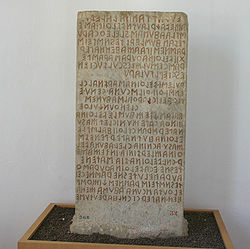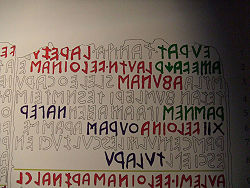- Cippus Perusinus
-
The Cippus Perusinus is a stone tablet discovered on the hill of San Marco, near Perugia, Italy, in 1822. The tablet bears 46 lines of Etruscan text exquisitely carved into it. This stone tablet is a memorial stele.
The cippus is assumed to be a text dedicating a legal contract between the Etruscan families of Velthina (from Perugia) and Afuna (from Chiusi), regarding the sharing or use of a property upon which there was a tomb belonging to the noble Velthinas.[1][2]
The date of the inscription is considered to be 3rd or 2nd century BCE. The Cippus is conserved in the National Archeological Museum of Perugia.[1]
Contents
Original Text
-
- Teurat tan-na larezu-l am-e vaχr.
- Lautn Velθina-ś, eśt-la Afuna-s, spel eθ car-u tezan,
- fuśler-i tesn-ś tei-ś Raśne-ś ipa am-a hen.
- Naper XII Velthinaθur-aś ar-aś,
- peraścem-ul mlesc-ul, zuci enesc-i ep-l, tular-u.
- Aule-śi, Velθina-ś Arnza-l, clen-śi,
- θi-i θi-l ścuna cen-u, epl=c feli=c Larθal-ś Afuni-ś,
- clan, θunχul θe fala-ś.
- Χi=em fuśl-e, Velθina hinθa cap-e, muni=cle-t, mas-u,
- naper śran=c zl, θi-i falś-ti.
- Veltina hut naper penez-ś mas-u.
- Acnina cl-el Afuna, Velθina mler zin-ia.
- In temam-er cn-l Velθina zi-a śaten-e tesn-e,
- Eca Velθinaθur-aś θaura hel-u tesn-e Raśn-e ce-i.
- Tesn-ś tei-ś Raśne-ś χimθ, śpel θuta ścu-na, Afuna men-a hen.
- Naper ci cn-l har-e ut-uś-e.
- Reverse side:
-
- Velθina śatena zuci enesc-i ipa spelane-θi fulum-χva.
- spel-θi, rene-θi.
- Esta=c Velθina, acil-un-e, tur-un-e, ścu-n-e.
- Ze-a zuci enesc-i aθumi=cś.
- Afuna-ś penθ-na am-a.
- Velθina, Afun[a]θur, un-i ei-n zeri, una cla θi-l θunχulθ-l.
- Iχ ca ceχa ziχ-uχ-e.
- Velθina śatena zuci enesc-i ipa spelane-θi fulum-χva.
See also
- Etruscan civilization
- Tyrrhenian languages
- Other Etruscan inscriptions:
Notes
References
- Bonfante, Giuliano; Bonfante, Larissa (2002). The Etruscan Language: an Introduction. Manchester, University of Manchester Press. ISBN 0-7190-5540-7.
- Cristofani, Mauro, et al. (1984). Gli Etruschi: una nuova immagine. Firenze, Giunti Martello. ISBN.
- Cristofani, Mauro (1979). The Etruscans: A New Investigation (Echoes of the ancient world). Orbis Pub. ISBN 0-85613-259-4.
- Rix, Helmut (1991). Etruskische Texte. G. Narr. ISBN 3-8233-4240-1. 2 vols.
External links
- The Etruscan Texts Project A searchable database of Etruscan texts.
Categories:- Etruscan language
- Perugia
- Steles
-
Wikimedia Foundation. 2010.


